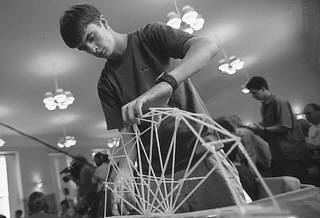|
|
Bridge-building Event Puts Pasta, and Students, to the TestBy Phil SneidermanHomewood |

The annual Spaghetti Bridge Contest, which requires engineering students to focus their skills on a popular cooking ingredient, will be staged this year at a new location. Students will pit their pasta creations against one another on Sunday, Nov. 11, in the Glass Pavilion at Levering Hall.
Previous competitions have taken place at the Maryland Science Center in the Inner Harbor. Because this year's contest is located on the Homewood campus, organizers hope many students and others in the Hopkins community will come by to watch the intricate noodle models compete to carry the most weight before collapsing. The bridges will go on view beginning at 1:30 p.m.. The weight competition will begin at about 3 p.m. There is no admission charge.
Under the rules of the contest, the bridges can be made only of spaghetti and glue (epoxy or resin). Each free-standing bridge must span two level surfaces that are 1 meter apart. Each bridge must include a decking of spaghetti wide enough to allow a "car," represented by a small block of wood, to pass over it.

|
| In one of Michael Karweit's past CTY classes, a student checks his spaghetti construction. The entries in Sunday's Spaghetti Bridge Contest will be twice as long as this one. |
During the judging, increments of weight are added gradually to a platform suspended from the middle of each bridge until the structure snaps. Its score is the greatest amount of weight the bridge carried before the collapse. This year, about 18 bridges are expected to compete, each made by a team of two or three students.
The Spaghetti Bridge Contest may sound like an amusing diversion, but it is actually one of the most challenging assignments in an introductory undergraduate course called What Is Engineering?
"The idea here is to take students through an entire engineering problem," says Michael Karweit, a Whiting School research professor who teaches the course.
First, he says, the students have to measure the properties of building materials--in this case, the spaghetti. Next, they have to learn about how weight or stress is distributed in a structure. Using a Web-based virtual laboratory, they can test how changing the geometry of the bridge will affect its strength.
"They also learn that there's a difference between design and construction," Karweit says. "Sometimes, you can have a wonderful design, but it's almost impossible to build it. The most important thing about the spaghetti bridge project is that this is a complete engineering problem, from design to construction--the whole ball of wax. And in a sense, it's open-ended. There's no single right answer."
Assignments like this sometimes help freshmen decide if they really wish to pursue an engineering major.
"This is a project where the students have to physically make something, instead of just solving a problem set or writing a paper," says Adrienne Via, a senior majoring in civil engineering and a teaching assistant in Karweit's course. "When I was a freshman, I had a good time with the spaghetti bridge because I liked the design aspects of it."
As the deadline for this year's contest approaches, Via has been offering advice and encouragement. "Some of the students are a little scared of it," she says, "and some think you can just throw the bridge together in a weekend.
"But the biggest challenge is actually putting it together. Some parts of the bridge are made of seven strands of spaghetti, and you have to figure out how to hold them together while you're gluing them. It's a lot of tedious work. The design is the easy part. Constructing is the hard part."
Karweit has also used a scaled-down version of the spaghetti bridge contest to introduce engineering concepts to younger students attending Center for Talented Youth classes at Hopkins during the summer.
| GO TO NOVEMBER 5, 2001 TABLE OF CONTENTS. |
| GO TO THE GAZETTE HOME PAGE. |